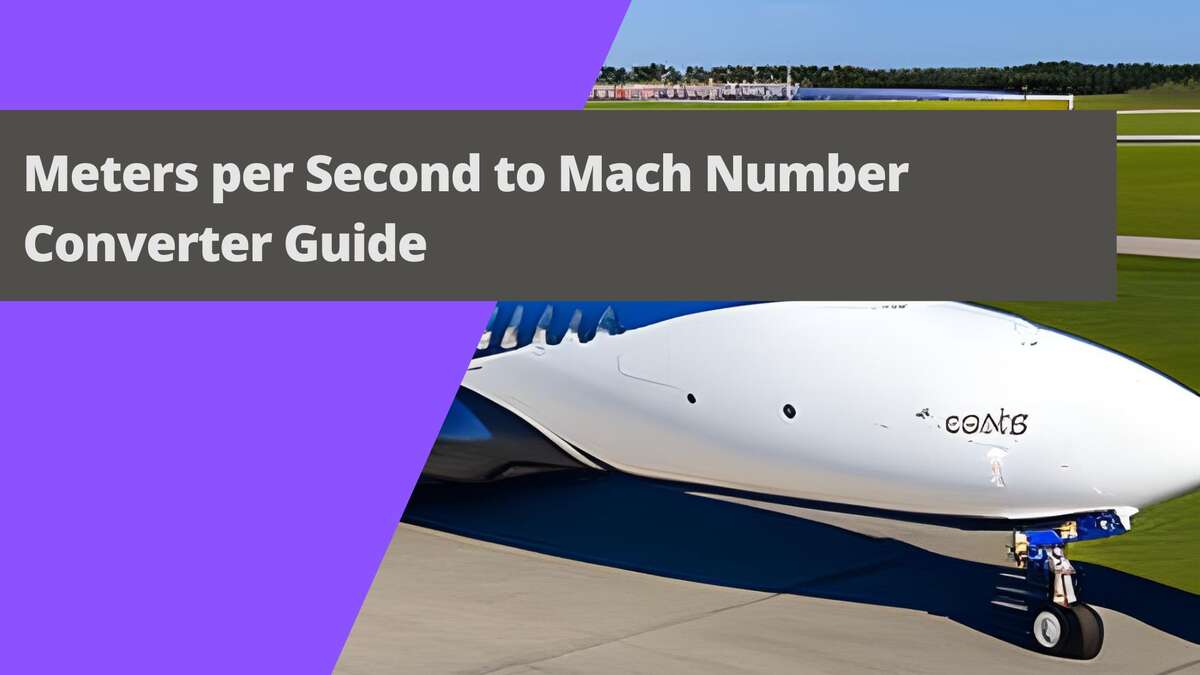Meters per Second to Mach Number Converter

- Introduction
- Definition
- Meters per Second
- Mach Number
- Formula
- Explaining Conversion Factors and Table
- Step-by-Step Guide
- Real-world Examples and Applications
- Frequently Asked Questions
- What are the different speed classifications based on Mach number?
- Why is the Mach number important in aerodynamics?
- Conclusion
When it comes to measuring speed, different units can be used depending on the context and application. In this comprehensive guide, we will discuss the Meters per Second to Mach Number Converter, including the definitions, formula, conversion factors and table, a step-by-step guide, real-world examples and applications, and frequently asked questions.
With a deeper understanding of these concepts, you can easily convert between meters per second and Mach number in various scenarios. So, let's get started!
Introduction
The Meters per Second to Mach Number Converter is a useful tool for individuals and professionals working in fields such as aviation, aerospace, and fluid dynamics. Converting between these units helps in understanding the speed of an object relative to the speed of sound, which can be crucial in designing aircraft, rockets, and other high-speed vehicles.
Definition
Meters per Second
Meters per second is a unit of measurement for speed, expressing the distance traveled in meters within one second. It is the SI derived unit for speed in the metric system and can be abbreviated as m/s or m/sec.
Mach Number
Mach number, also known as Mach, is a dimensionless quantity representing the ratio of an object's speed to the speed of sound. It is commonly used in fields such as aerodynamics and aeronautics. Mach can be abbreviated as M or Ma.
Formula
To convert meters per second to Mach number, multiply the speed in meters per second by the conversion factor 0.002915:
Mach number = meters per second × 0.002915
Explaining Conversion Factors and Table
The conversion factor 0.002915 is derived from the speed of sound at sea level under standard atmospheric conditions, which is approximately 343 meters per second. The table below provides a quick reference for converting between meters per second and Mach number:
| Meters per Second | Mach Number |
|---|---|
| 85.75 m/s | Mach 0.25 |
| 171.5 m/s | Mach 0.5 |
| 257.25 m/s | Mach 0.75 |
| 343 m/s | Mach 1 |
| 514.5 m/s | Mach 1.5 |
| 686 m/s | Mach 2 |
| 857.5 m/s | Mach 2.5 |
| 1,029 m/s | Mach 3 |
| 1,201 m/s | Mach 3.5 |
| 1,372 m/s | Mach 4 |
| 1,544 m/s | Mach 4.5 |
| 1,715 m/s | Mach 5 |
Step-by-Step Guide
Follow these steps to convert meters per second to Mach number:
- Determine the speed in meters per second.
- Multiply the speed by the conversion factor 0.002915.
- The result is the Mach number.
Real-world Examples and Applications
Converting between meters per second and Mach number is essential in several real-world scenarios, such as:
- Aerospace engineering: Designing and analyzing the performance of aircraft, rockets, and spacecraft at various speeds.
- Wind tunnel testing: Evaluating the aerodynamic properties of vehicles, structures, and materials at different Mach numbers.
- Weather forecasting: Analyzing wind speeds and their effects on weather systems, as well as understanding the behavior of shock waves and sonic booms.
Frequently Asked Questions
What are the different speed classifications based on Mach number?
Speed classifications based on Mach number are:
- Subsonic: Mach < 1.0
- Transonic: Mach ≈ 1.0
- Supersonic: Mach > 1.0
- Hypersonic: Mach > 5.0
Why is the Mach number important in aerodynamics?
The Mach number is crucial in aerodynamics because it helps determine the flow regime around an object, such as an aircraft or a projectile. Different flow regimes, such as subsonic, supersonic, and hypersonic, are characterized by different fluid dynamics phenomena, such as the formation of shock waves and the behavior of boundary layers. Understanding these phenomena is essential for designing high-speed vehicles and predicting their performance.
Conclusion
The Meters per Second to Mach Number Converter is a valuable tool in various fields, such as aviation, aerospace engineering, and meteorology. Understanding the definitions, formulas, and conversion factors enables you to accurately convert between these units and apply this knowledge in real-world applications. We hope this comprehensive guide has provided you with the necessary information to perform these conversions with confidence.
For more information and tools related to speed conversions, please visit these resources:









